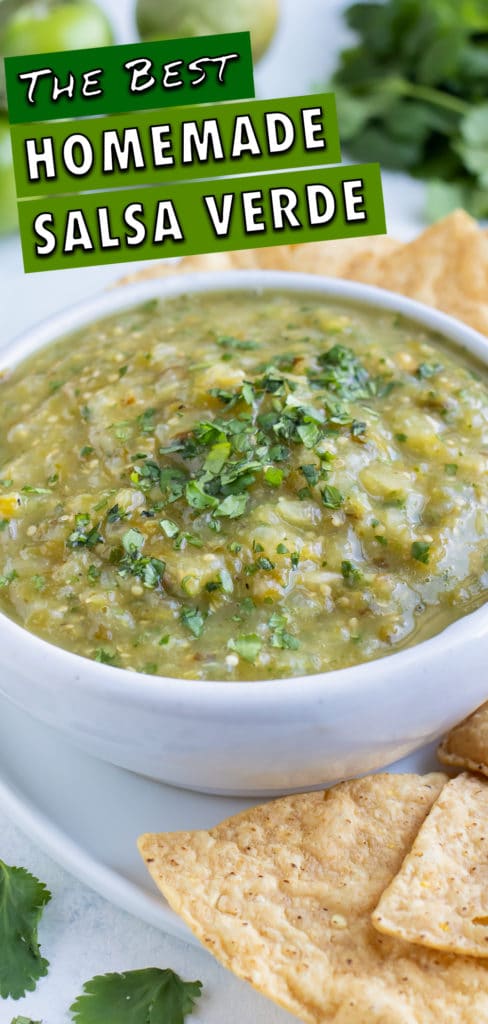Tomatillo Salsa Verde is a classic green sauce that is loaded with spicy flavor and is secretly so easy to make at home! Tomatillos are roasted in the oven with peppers, onion, and garlic and then blended together until thick and chunky. This authentic verde recipe tastes just as good as your favorite Mexican restaurants’ and is incredible when paired with tortilla chips, enchiladas, tacos, or on top of chicken for Cinco de Mayo.
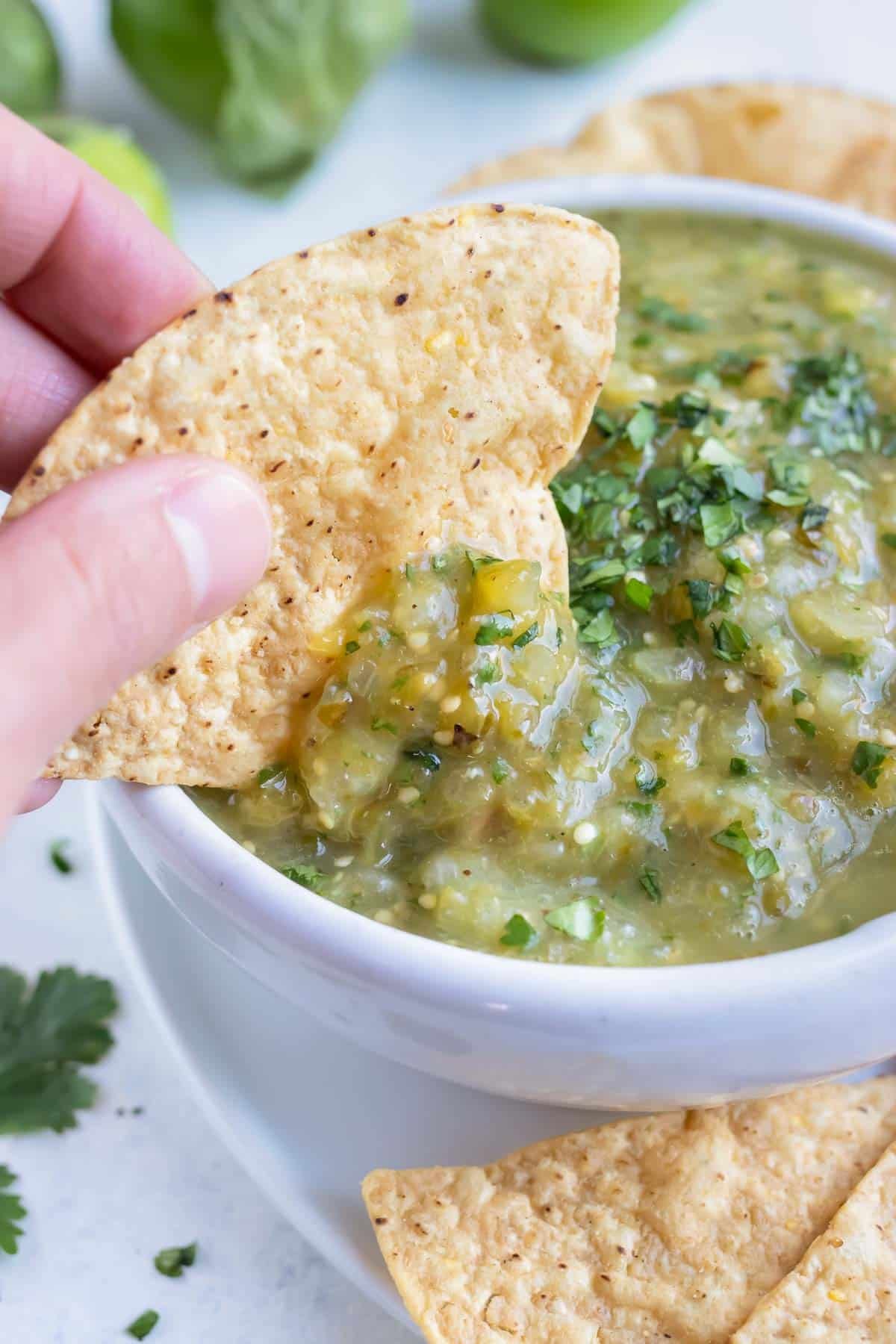
Best Salsa Verde Recipe
The first time I really ever fell in love with Tomatillo Salsa Verde was when I tried Enchiladas Verde with Chicken.
The green sauce was less sweet than regular salsa, had a wonderfully thick texture, and a very uniquely bright flavor I couldn’t quite put my finger on.
For years I continued to make those verde enchiladas with a jar of the Herdez salsa, never even considering that I could make my own green sauce at home.
And then Salsa Week happened at my house. Once I learned how easy it was to make a Roasted Salsa at home, I realized that a salsa verde couldn’t be all that different, right?!
In fact, the only real difference between a classic salsa and a salsa verde is the main ingredient used, with either tomatoes or tomatillos. I had to get my hands on some tomatillos!
Fortunately for me, I live in Texas where there is an abundance of Mexican cuisine ingredients, so locating these green tomato doppelgangers was pretty easy. (Well, that is, AFTER I realized what tomatillos looked like when they’re wrapped in husks!)
In less than an hour I had tortilla chips in hand and was munching my way through my own authentic, homemade salsa verde—so fresh, and super quick and simple to make!
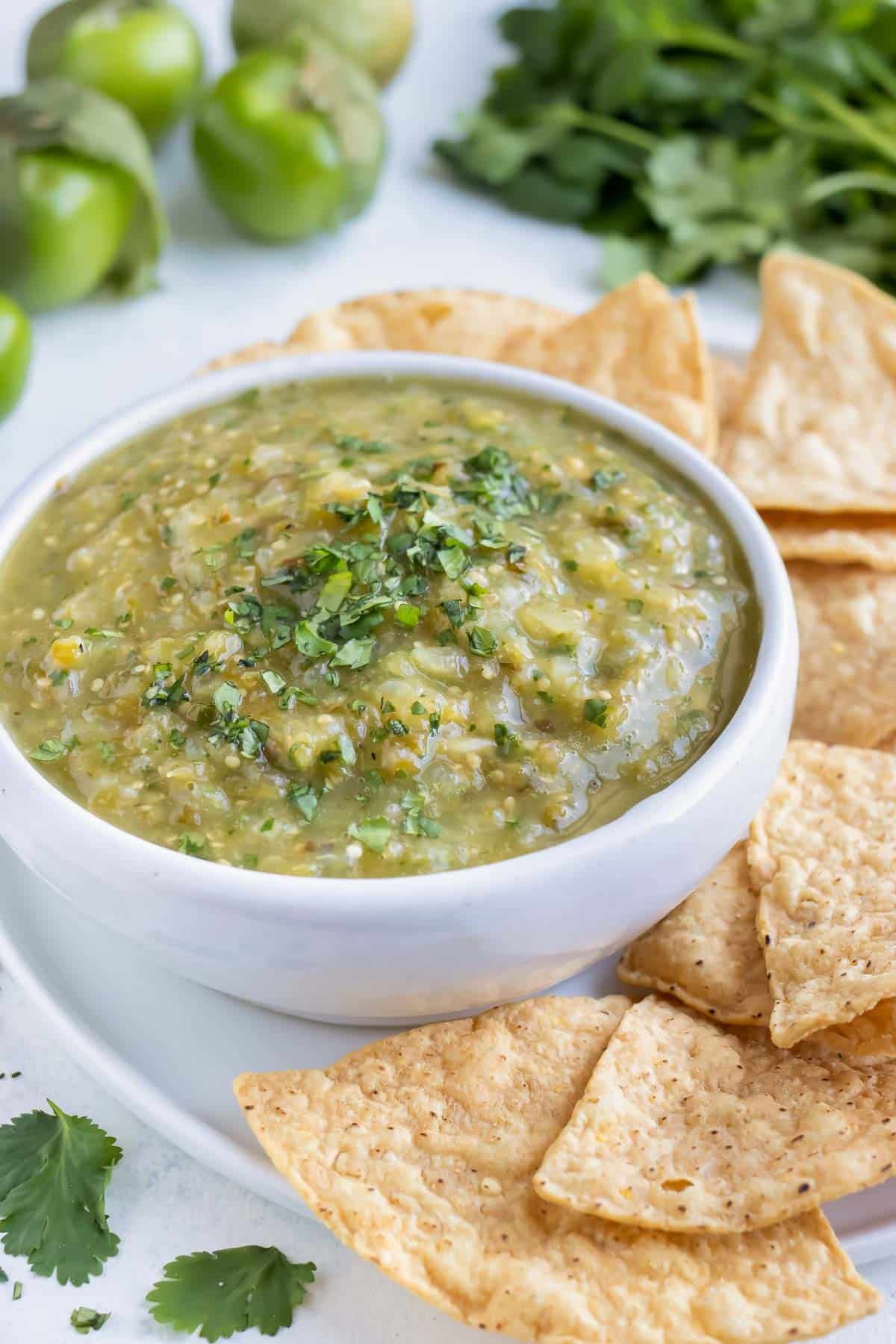
What Is Salsa Verde?
Salsa verde means “green sauce” in Spanish and is traditionally made from roasted tomatillos, spicy peppers, onion, cilantro, and lime juice. It is often served as a dip with tortilla chips, or to flavor main dishes such as enchiladas, tacos, or chicken. Most grocery stores carry store-bought versions, but it’s simple to make your own authentic salsa verde recipe at home.
What Are Tomatillos?
Tomatillos differ from regular tomatoes in that they are slightly more acidic, less sweet, and deliver a lighter and brighter flavor to a dish. These small green tomatillos come with a husk around them that must be removed and there is often a sticky layer underneath that must also be rinsed off before eating.
They are primarily grown in Mexico and in the Southwestern regions of the United States and are often used in Mexican cuisine. They can be traced back to the Aztec empire.
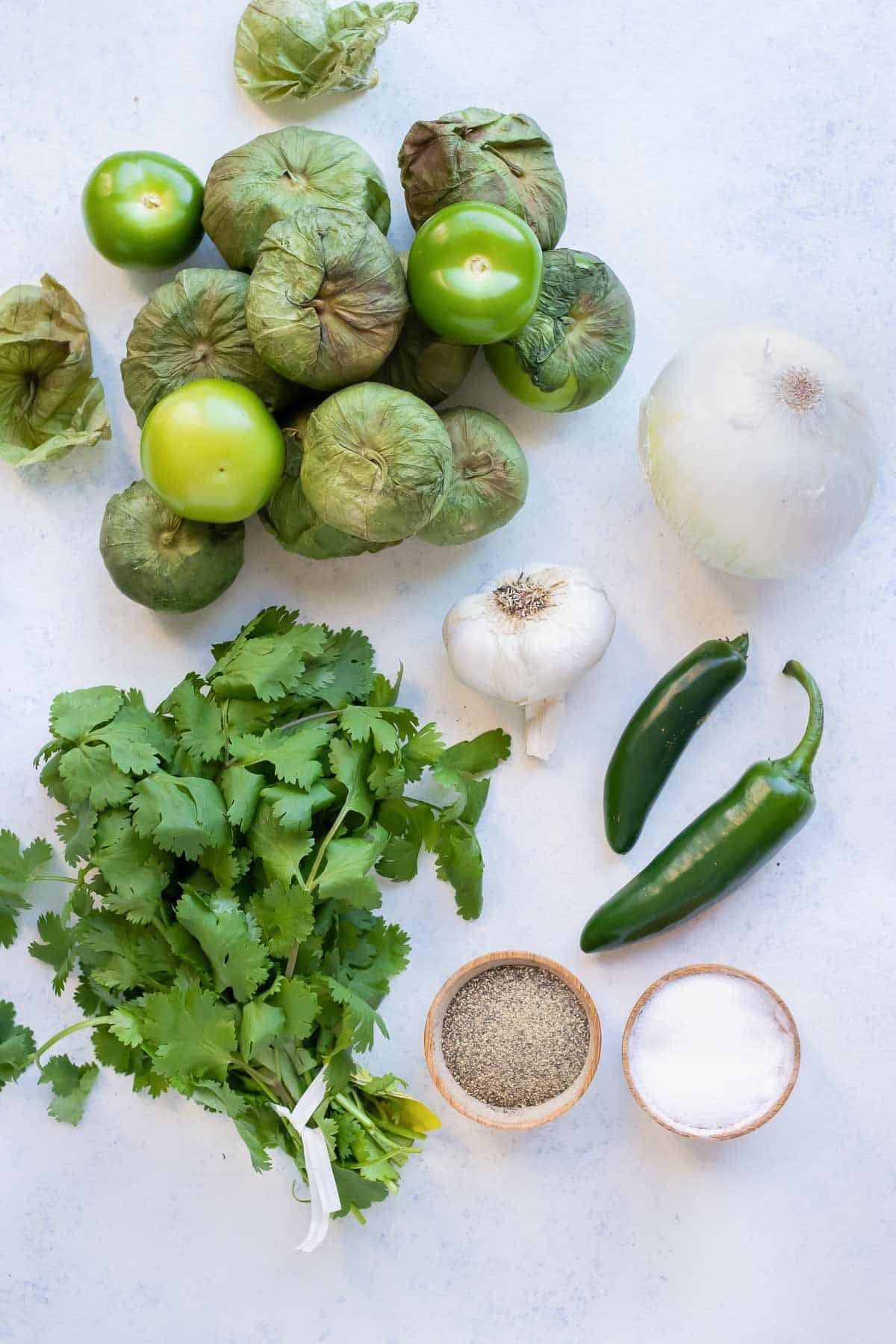
Salsa Verde Ingredients
The fresh ingredients you need to make this tomatillo salsa verde at home include:
- Tomatillos. The main ingredient! These bright green vegetables can be found in your local grocery store and normally come with their husks still intact. Look for ones that are a vibrant green color and are still firm for the best taste and texture.
- Onion. Either a sweet or white onion can be used. A sweet onion will add a subtle sweetness to the salsa that helps to balance out the spicy flavors, while a white onion is the more authentic type to use.
- Peppers. Jalapeño peppers will give the salsa a slightly milder flavor while serrano peppers will make it spicier. You can either use one pepper for a mild salsa or two peppers for a medium-heat salsa.
- Garlic. Roasted fresh garlic cloves are key to giving the salsa a robust taste. You can substitute with garlic powder but it won’t deliver the same punch of flavor as fresh.
- Cilantro. Salsa wouldn’t be complete without a good bit of fresh cilantro. Make sure you remove the leaves from the stems to get the most flavor. Also, pack the cilantro down when measuring it out. You should end up using close to ½ of a bunch.
- Lime Juice. Fresh lime juice adds a zesty bit of citrus and also helps to preserve the dip and keep its color from turning.
How to Make Salsa Verde
Below, you’ll find the steps to make this easy salsa verde recipe:
How to Prepare Tomatillos
Before you can roast the vegetables, you first need to prepare the green tomatillos.
Here’s an easy way:
At the base of the tomatillo, pinch any excess husk with your pointer finger and thumb and then pull it to tear the husk away from the tomatillo. Continue peeling the papery husk towards the stem until the entire tomatillo is exposed.
With all of the husk and the stem in-between your thumb and pointer finger, pinch the stem and twist it slightly to remove it.
Rinse the tomatillo under cold running water to remove all of the sticky coating.
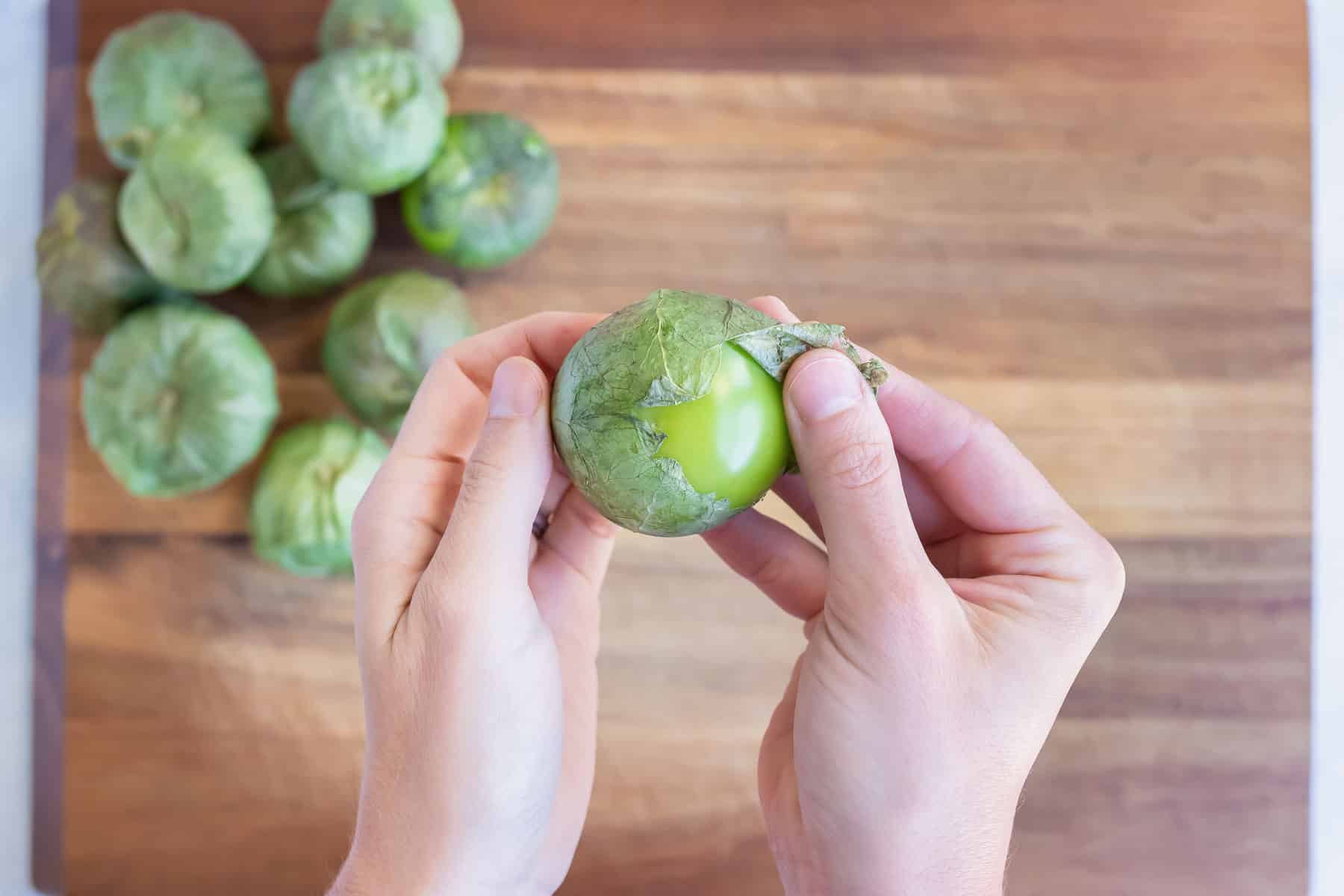
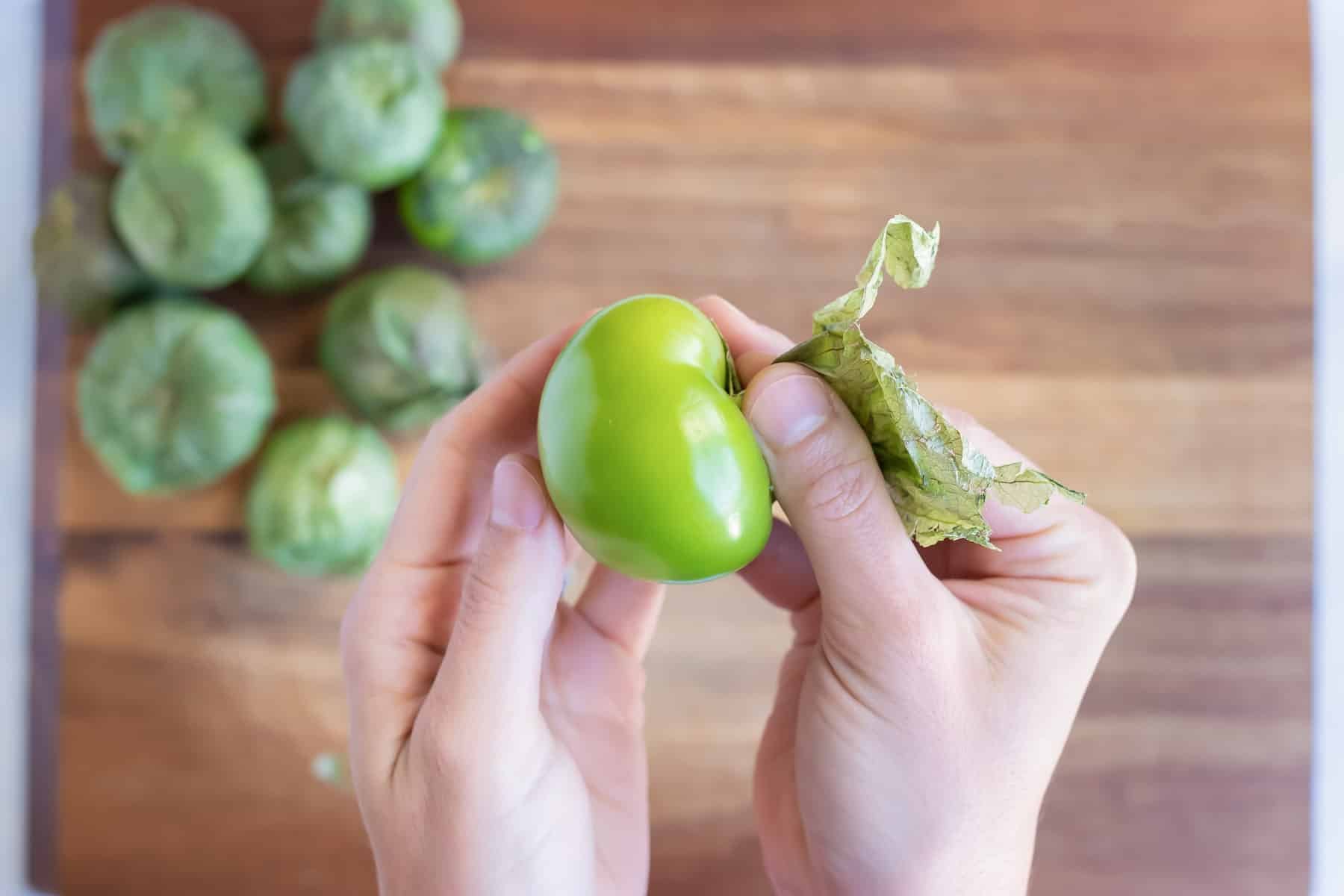
How to Cook Tomatillos
Once you have all of the tomatillos prepped, it’s time to start roasting and salsa making!
Roasting tomatillos brings out their naturally occurring sugars and results in a subtly sweet flavor.
Place the tomatillos and jalapeño peppers onto a large baking sheet along with the quartered onion and garlic cloves. It’s important that the tomatillos and peppers face stem- and skin-side up so the skin has a chance to brown and caramelize.
Drizzle oil over all of the vegetables and rub it into their skin. Lift them up while you’re doing this so a little bit also gets underneath. Be sure to leave the skin on the garlic!
Roast the vegetables in a 450°F oven. Pull the garlic cloves out of the oven after 15 minutes to prevent burning. Keep cooking the rest for an additional 5-10 minutes, or until the tomatillos begin to brown
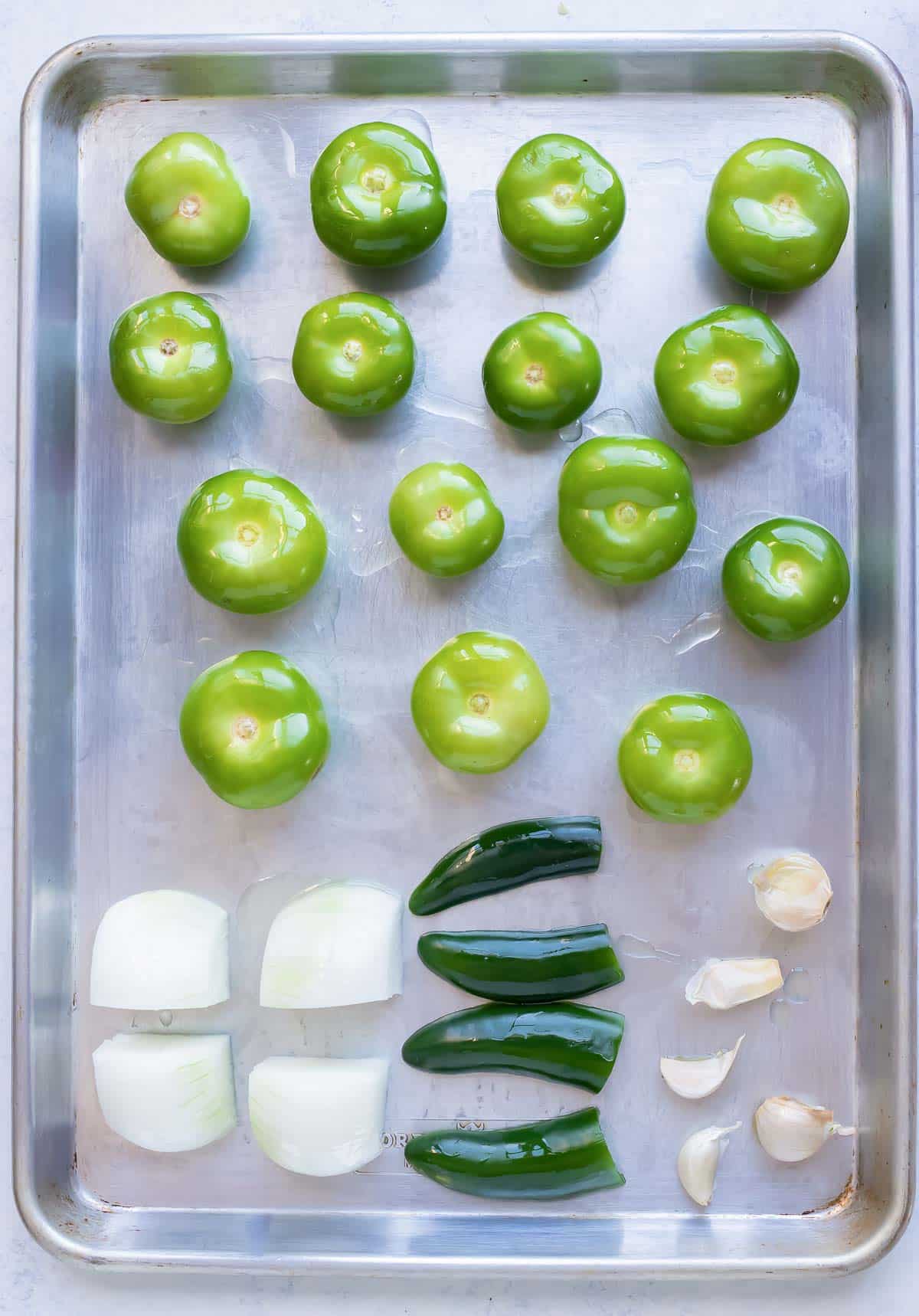
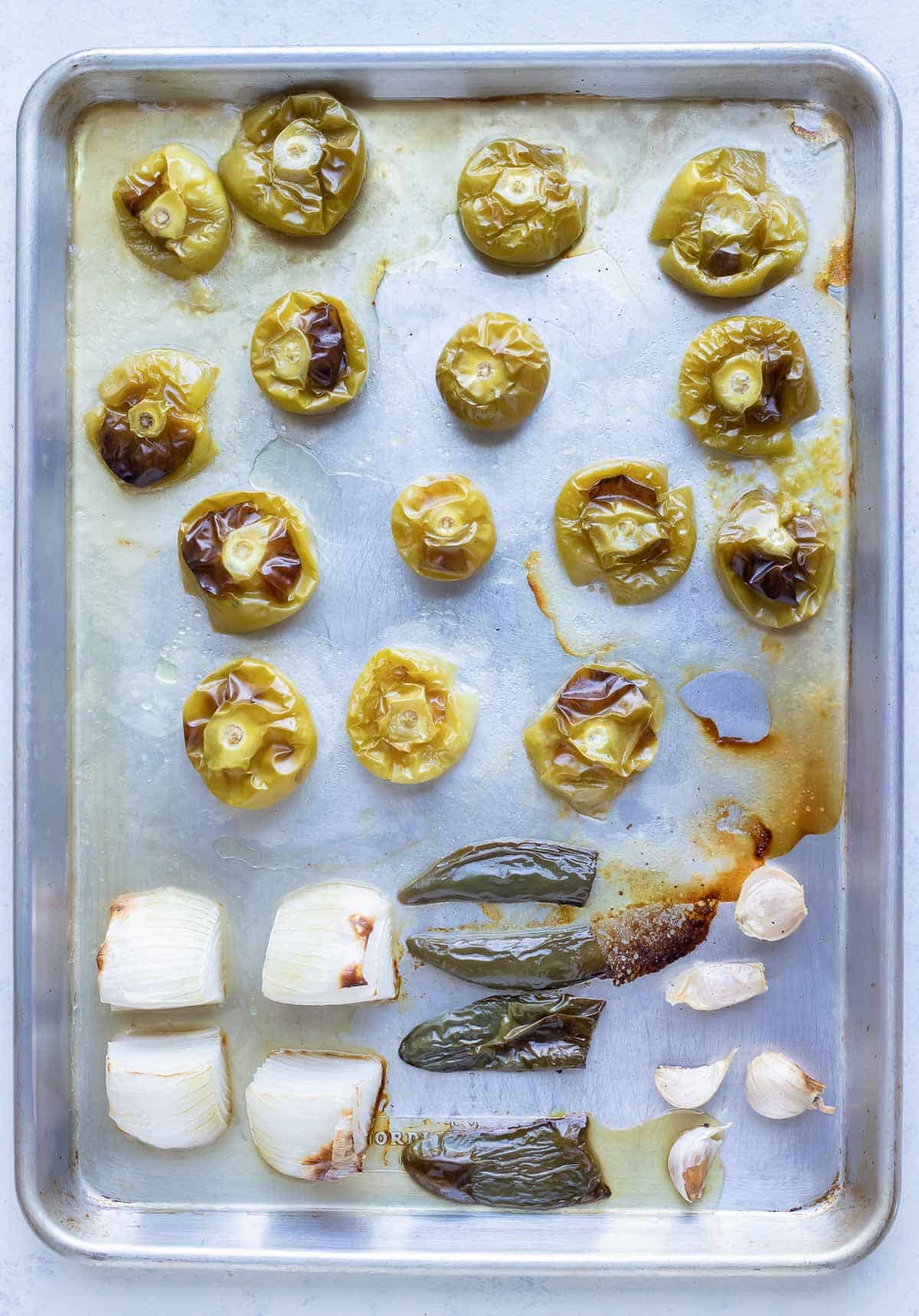
Make the Salsa
Add the roasted tomatillos, onion, jalapeño, garlic cloves, and any oil on the baking sheet to a large food processor along with the remaining ingredients.
Make sure you peel the garlic cloves before adding them into the processor!
Pulse the ingredients 10-20 times and then scrape down the sides of the bowl. Continue pulsing until the salsa reaches your desired consistency (about 40-50 times).
It’s important that you pulse and don’t purée. This helps you better control the final consistency of the salsa and gives you time to adjust the seasonings to your taste preference. While you don’t want big chunks of tomatillo, you also don’t want it completely blended.

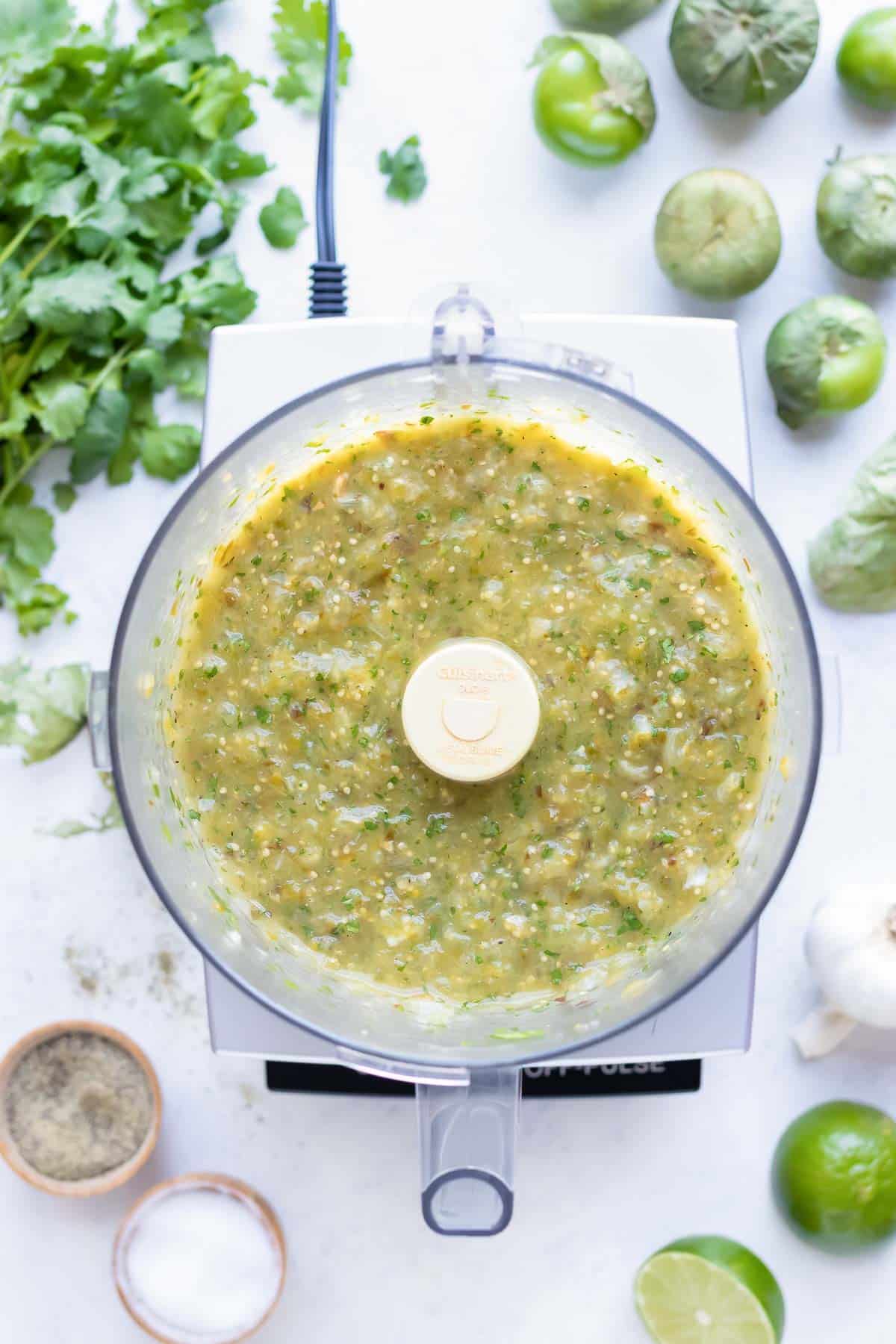
Meal Prep and Storage
- To Prep Ahead: Salsa verde gets better after it sits for a few hours, so prep it ahead of time and pull it out just before serving.
- To Store: Homemade salsa will keep well for up to 4-6 days when stored in an airtight container in the refrigerator.
- To Freeze: Frozen salsa will end up with a layer of water on the top once thawed. To prevent this, add salsa that you’d like to freeze to a saucepan over medium-low heat and cook it down for 30-45 minutes. Doing this will remove most of the extra moisture and result in a better frozen salsa.
- To Reheat: Roasted salsa tastes delicious when served warm or cold. If you’d like to serve it warm simply reheat it in a medium-sized saucepan over medium heat for 2-3 minutes just before serving.
Is salsa verde spicy?
Salsa verde is generally considered quite spicy. However, making a homemade salsa verde recipe allows you to customize how much heat there is. Salsa verde is a little more acidic, lighter, and brighter than traditional salsa and is full of fresh cilantro flavor. It can vary in spice level depending on the amount and types of green chili peppers used.
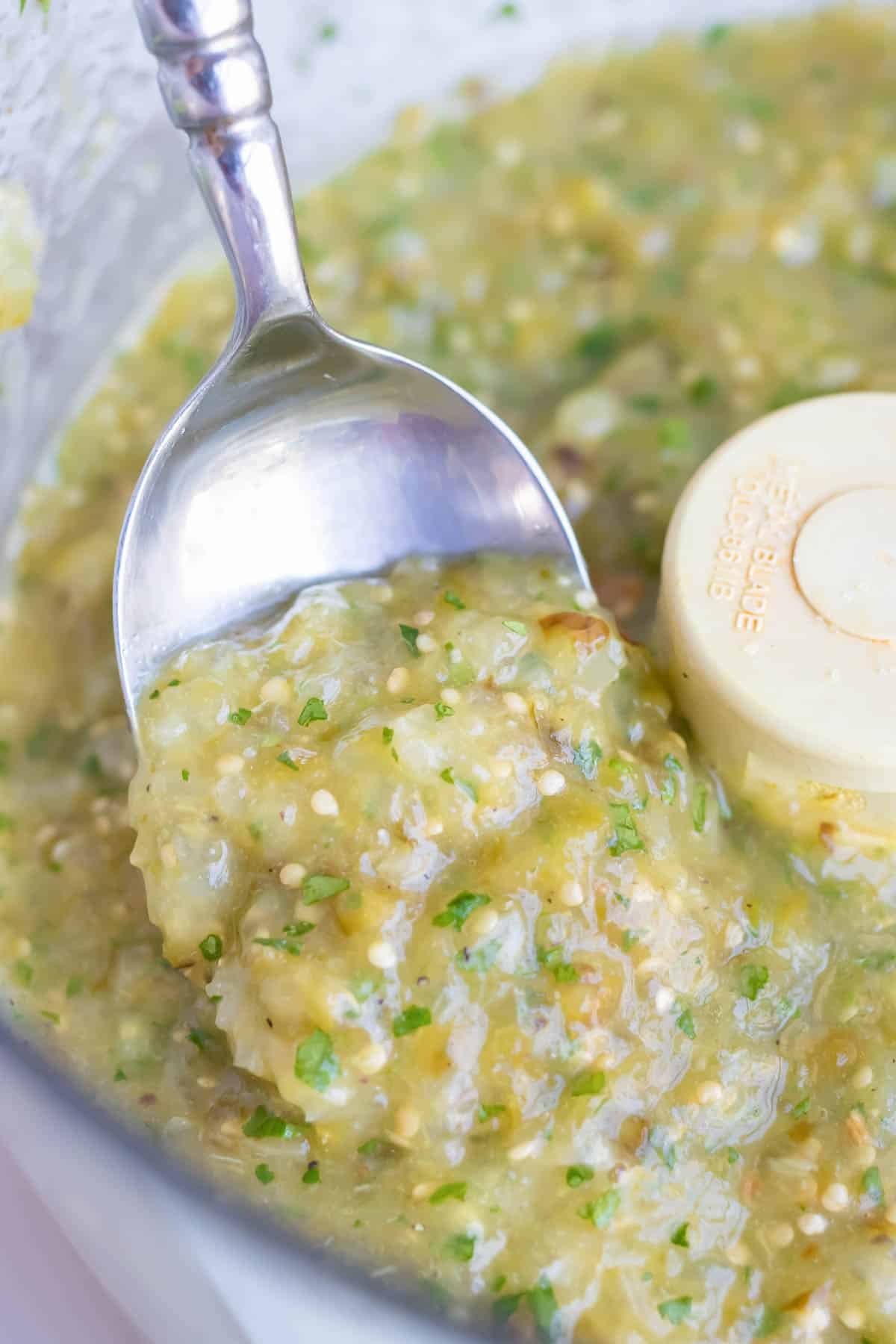
What’s in salsa verde?
This vibrant salsa usually contains tomatillos, jalapeño peppers, onion, garlic, lime, and cilantro. You can include different peppers to create different levels of spice, though.
Expert Tips and Tricks
- Stay consistent. Smaller tomatillos will roast up faster than larger so make sure to look for ones that are a similar size.
- Go for sweet or white. Sweet onion will give the salsa a subtle sweetness, but white onions will also work well. Avoid using yellow or red onions since they will give the salsa a pungent flavor.
- One or two. Use 1 pepper for a mild salsa, 2 peppers for medium. You can choose to use either jalapeño or serrano peppers.
- Take the garlic out early. Garlic cooks up pretty quickly and will burn if it is left in too long with the other vegetables.
- Pulse and don’t purée. This helps you better control the final consistency of the salsa and gives you time to adjust the seasonings to your taste preference.
- Let it meld. The salsa develops an even deeper, richer flavor as it sits in the refrigerator, so it’s best if you prep it at least a few hours in advance!
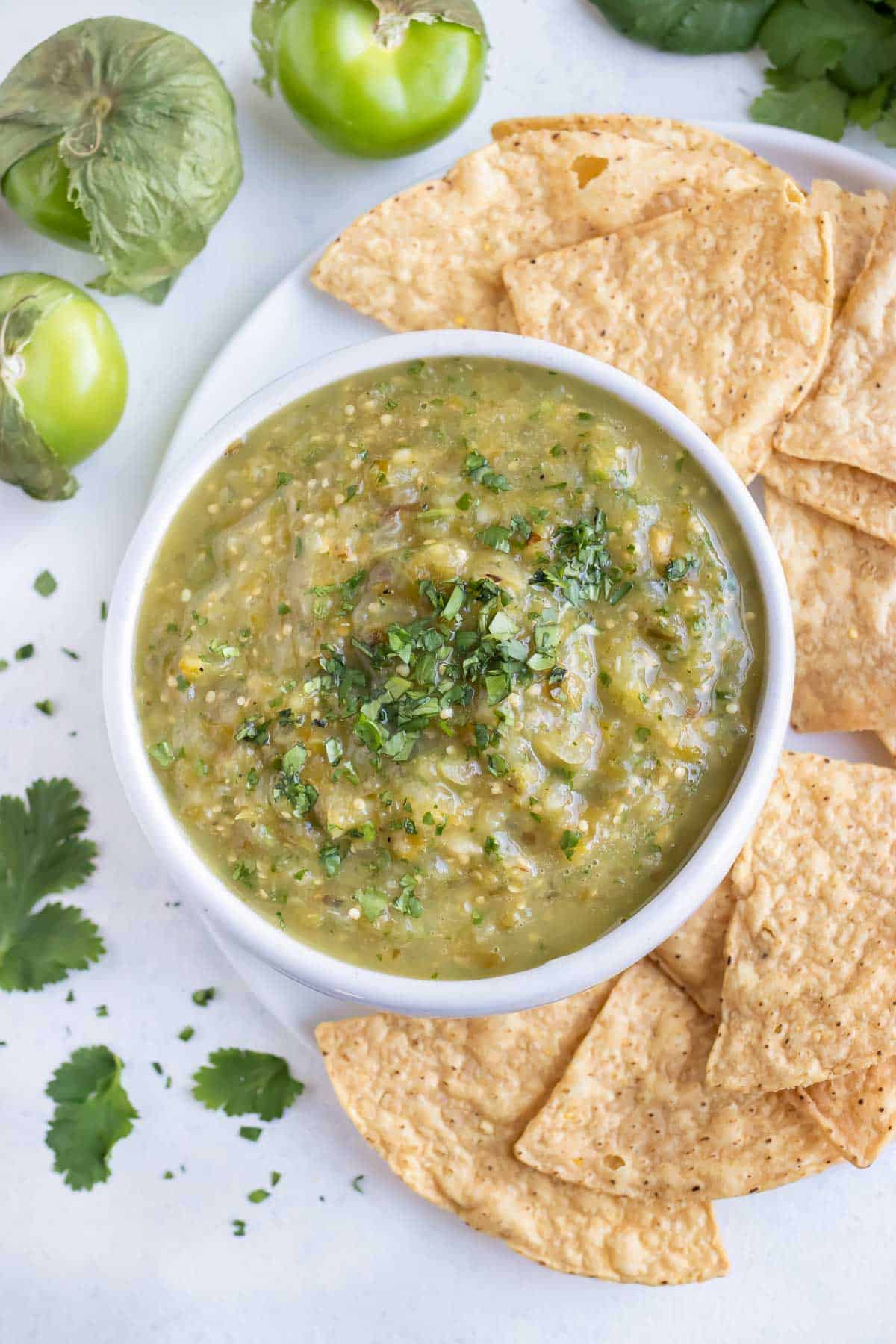
What To Do With Salsa Verde?
If you don’t already devour the entire batch of salsa verde with some homemade tortilla chips, then you can also use it up in one of these recipes.
Chicken Enchiladas Verdes are a classic that everyone will love.
Instant Pot Shredded Salsa Chicken and Easy Shredded Chicken Tacos are surprisingly easy.
Of course, Sweet Potato Black Bean Enchiladas are super delicious.
More Salsa Recipes
You might be surprised at how simple it actually is to make your own salsa at home. Try these easy salsa recipes next.
Roasted Tomato Salsa, Pico de Gallo, Creamy Avocado Salsa Verde, and Fresh Tomato Salsa are my favorites.
Fresh Mango Salsa, Mango Avocado Salsa, and Pineapple Pico de Gallo are fruit-forward versions the whole group will love.
Not exactly salsa, but Shrimp Ceviche and this Classic Ceviche are both delicious Mexican dips!
Tap stars to rate!
Tomatillo Salsa Verde Recipe

email this recipe!
Ingredients
- 1 ¾ lbs. tomatillos husks removed
- 1 medium onion sweet or white
- 1-2 jalapeño peppers or serrano peppers
- 4-6 garlic cloves
- 2 Tbsp. oil avocado or olive
- ½ cup cilantro leaves packed
- 1 Tbsp. lime juice freshly squeeze
- 1 tsp. salt
- ¼ tsp. black pepper
Instructions
- Preheat oven to 450°F.
- Remove the husks and stems from the tomatillos and then rinse and scrub them thoroughly to remove the sticky coating.
- Trim the stems from the peppers, cut them in half lengthwise, and scoop out all of the seeds.
- Trim the ends from the onion, peel the outer layer of skin, and then cut it into quarters.
- Place the tomatillos stem-side up and jalapeño peppers skin-side up onto a large baking sheet along with the quartered onion and garlic cloves.
- Drizzle oil over all of the vegetables and rub it into their skin.
- Roast the vegetables in the preheated oven for 20-25 minutes, or until the tomatillo skins begin to brown. Pull the garlic cloves out after 15 minutes to prevent burning.
- Add the roasted tomatillos, onion, jalapeño, garlic cloves that have been peeled, and any oil on the baking sheet to a large food processor along with the remaining ingredients.
- Pulse ingredients 10-20 times and then scrape down the sides of the bowl. Continue pulsing until the salsa reaches your desired consistency. (About 40-50 times.)
- Serve immediately or store in the refrigerator for up to 24 hours for an even better flavor. Salsa will keep well for up to 4-6 days when stored in an airtight container in the refrigerator or up to 2-3 months if frozen.
Tap stars to rate!
Video
Notes
Meal Prep and Storage
- To Prep Ahead: Salsa verde gets better after it sits for a few hours, so prep it ahead of time and pull it out just before serving.
- To Store: Homemade salsa will keep well for up to 4-6 days when stored in an airtight container in the refrigerator.
- To Freeze: Frozen salsa will end up with a layer of water on the top once thawed. To prevent this, add salsa that you’d like to freeze to a saucepan over medium-low heat and cook it down for 30-45 minutes. Doing this will remove most of the extra moisture and result in a better frozen salsa.
- To Reheat: Roasted salsa tastes delicious when served warm of cold. If you’d like to serve it warm simply reheat it in a medium-sized saucepan over medium heat for 2-3 minutes just before serving.
Nutrition
Nutrition information is automatically calculated, so should only be used as an approximation.

